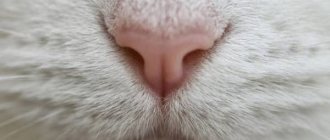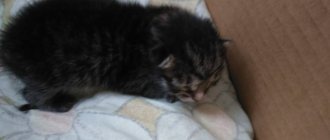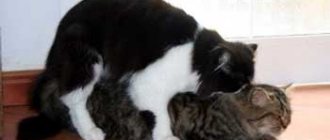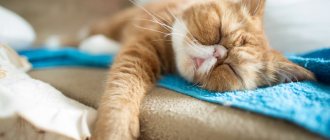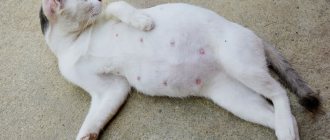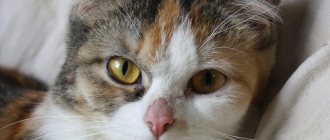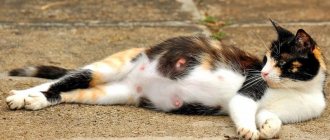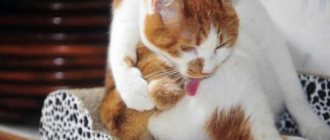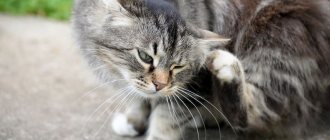11422Pavel
1
If an animal has nasal discharge, then the pet urgently needs treatment. Pus from a cat's nose can form due to allergies, a virus, or mechanical damage. You can find out what caused the snot from your veterinarian.
Pus from the nose of a kitten or an adult cat can be of a different nature.:
- Serous;
- Mucous;
- Mucopurulent;
- Purulent;
- Bloody;
- Bloody-purulent.
© shutterstock
If a cat has pus flowing from its nose, which prevents it from breathing and changes its color to yellow or green, then the pet should be taken to the doctor immediately. Yellow discharge most often indicates a bacterial infection in your pet. If they have a yellowish tint, then the pet is infected with a viral infection.
Causes
Pus from the nose
Diseases in which pus is discharged from the nose are divided into contagious and non-contagious.
The following are considered contagious:
- Herpes (rinotracheitis);
- Calicivirus;
- Cat flu;
Among the diseases of non-contagious etiology, the following most often develop:
- chronic diseases and colds;
- foreign bodies;
- congenital anomalies;
- tumors.
The causes of diseases, clinical symptoms, methods of diagnosis, treatment and prevention are not the same. Let's consider each disease separately.
Herpes (rhinotracheitis)
Herpes
The disease occurs among unvaccinated cats when kept in crowded conditions, unbalanced feeding in nurseries or shelters. Sick kittens die 10-14 days after the first signs appear. Those who have recovered become a reservoir of infection. There is a high probability of transplacental infection. The owner brings the virus into the apartment.
In addition to nasal discharge and cough, stomatitis, conjunctivitis with subsequent ulceration of the cornea, and mouth breathing develop. Constipation occurs and pregnant women abort. In the chronic course of the disease, panophthalmitis develops and the cat goes blind. An accurate diagnosis is established in the clinic.
The treatment is developed by a veterinarian. Prevention consists of timely vaccination, bringing living conditions and feeding into compliance with standards. If a cat refuses to eat for a long time, it is fed through a nasoesophageal tube. If signs of dehydration are detected, droppers with plasma substitutes are placed.
Nasoesophageal tube
When the cat begins to feed on its own, the veterinarian prescribes wet canned food or soaked granules.
Be sure to read:
The cat drinks a lot of water: reasons, what to do if the animal is losing weight, how to help
Calicivirus
Ulcerative glossitis with calcivirosis.
In terms of symptoms, etiology, and pathogenesis, the viral disease resembles Herpes. A cough occurs and bronchopneumonia develops.
Distinctive features are ulcerative stomatitis and the absence of ulcerations on the cornea. Lameness appears suddenly, but disappears spontaneously after a few days. The treatment strategy and prevention are the same as for Herpes.
Cat flu
Polyvalent vaccine
Often Herpes and Calicivirus affect a pet at the same time. The disease was called cat flu. When making a diagnosis, attention is paid to the presence of signs of both diseases. A complex vaccine against calicivirus, rhinotracheitis and panleukopenia reliably protects against infection.
Cat flu is not dangerous to humans.
Why does pus flow from the eyes?
In a cat, purulent eye discharge is usually accompanied by profuse lacrimation, constant squinting, painful reaction of the affected organ to light, redness, deterioration in general health (lethargy, decreased motor activity, problems with sleep, complete or partial refusal to eat). This problem may occur due to:
Conjunctivitis
- Inflammation of the conjunctiva (the thin mucous membrane lining the outer surface of the eyeball and the inner area of the eyelids) of bacterial origin.
- Inflammation of the ciliated edge of the eyelids (blepharitis), which is essentially a severe form of conjunctivitis. This disease can be superficial (the inflammatory process does not affect the deep layers of the eyelid) and deep (the ciliary roots and meibomian glands are affected).
- Contact with a foreign body in the eye.
- Infections of viral, fungal and bacterial origin.
Symptoms accompanying eye suppuration depend on the underlying disease. Information about them is presented in the table:
Blepharitis
| Diseases and conditions that provoke the discharge of pus from the eyes | Reason for development | Clinical picture (in addition to organ putrefaction) | |
| Bacterial conjunctivitis | Bacteria |
| |
| Foreign body entry | Mote, dust, dirt |
| |
| Blepharitis | Bacteria, viruses, fungi, parasites, mechanical damage |
| |
| Infections | Viral | Viruses |
|
| Bacterial (mycoplasmosis, chlamydia) | Bacteria |
| |
| Fungal (coccidioidomycosis) | Fungi |
| |
Sphinx's eyelids turn upside down
Some breeds, particularly Sphynxes, are prone to eye infections. This is due to their predisposition to the development of chronic conjunctivitis due to inversion of the eyelids. The eyelashes scratch the ocular surface of these animals, causing increased tear production and inflammation. Blepharitis is most often detected in representatives of the Persian and Burmese breeds.
Chronic diseases and colds
Rhinitis occurs as a symptom of exacerbation of the following permanent diseases:
- diabetes;
- urolithiasis disease;
- renal pathologies.
Too frequent bathing leads to hypothermia and reflex swelling of the mucous membrane. Ventilating rooms freshens the air, however, cats cannot tolerate drafts and become hypothermic. In hot weather, you should not leave your pet in a room with air conditioning running, otherwise he will catch a cold.
If the disease is caused by hypothermia, and the pet’s health is satisfactory, use dual-use drops - Maxidin or Anandin. Drugs intended for humans should not be used without the approval of a veterinarian.
What to do if your cat's nose is festering
As a rule, a complex treatment of the cat is carried out, aimed at normalizing the respiratory function and general condition of the animal.
The following is used in treatment:
- antibacterial, antiparasitic agents in injections, tablets, drops;
- antifungal drugs;
- immunomodulators;
- homeopathy remedies;
- physiotherapeutic procedures;
- alternative medicine.
Congenital anomalies
Spontaneous selection leads to the birth of offspring predisposed to rhinitis. Sometimes kittens are born with a deviated nasal septum.
Hypothermia or a reaction to odors leads to reflex swelling of the mucous membrane and rhinitis. Atopic dermatitis occurs in predisposed cats over one year of age. This is a reaction to dust, smoke and odors. Along with a runny nose, cats develop cough, conjunctivitis, and skin diseases.
Be sure to read:
Why does a kitten sneeze: the main reasons, what to do, how to treat, when to contact a veterinarian
Congenital anomalies are incurable. However, with a successfully developed therapeutic strategy, exacerbations can be stopped.
Rhinotracheitis, calcivirosis and other upper respiratory tract infections
Feline upper respiratory tract infection is a general term for respiratory infections caused by one or more viral or bacterial agents.
The infection may be caused by one or more viral and/or bacterial agents. The most common viruses that cause upper respiratory tract infections in cats are:
- Herpesvirus type 1 is also known as feline rhinotracheitis virus or FVR.
- Calcivirosis (FCV).
The most common bacteria that cause upper respiratory tract infections in cats are:
- Bordetella bronchiseptica.
- Chlamydophila felis.
Rhinotracheitis and calcivirus cause approximately 90% of all secondary respiratory tract infections in cats. Other, less common pathogens that can lead to purulent discharge and inflammation of the nose are:
- Mycoplasmosis.
- Rotavirus.
Treatment
To make your pet's breathing easier at home, it is necessary to clear his sinuses of dried pus. To do this, use solutions of boric acid 2% or zinc sulfate 1%. You can also purchase special nasal hygiene products at a pet store.
Attention ! Any medical manipulations with an animal must be carried out after agreement with a veterinarian!
If a cat has pus flowing from his nose due to a viral infection, he is prescribed antiviral and immunostimulating drugs. In some cases, therapy is supplemented with antibiotics in the form of tablets or injections.
To make breathing easier, veterinarians prescribe vasoconstrictors and drying agents, antibacterial and antiviral nasal drops (Anandin, Vilprafen, Gamavit, Timogen). Place 1-2 drops in each nostril. For convenience, the cat must be fixed, the head raised and tilted slightly to one side, and after instillation, the drug must be allowed to act for some time. The minimum duration of therapy is 5 days.
Treatment of panlekopenia involves taking antiviral drugs (Vitafel, Immunoglobulin, Fosprenil, Enterostat). To eliminate the symptoms of dehydration and intoxication, injections of sodium chloride solution are given. To prevent the development of a secondary infection, the cat is prescribed antibiotics.
To treat toxoplasmosis, the drugs Pyrimethamine, Daraprim, Tindurine are used in combination with sulfonamides. Intoxication can be reduced by injecting a glucose solution into a vein.
Treatment of feline chlamydia is long-term (about a month) and consists of antibiotic therapy and topical use of tetracycline-based products.
During the period of treatment of the above infectious diseases, the cat should be isolated in a separate room, and its household items should be disinfected or boiled.
How to properly treat a kitten's eyes
The duration and course of the disease depends on the careful implementation of the procedures prescribed by the veterinarian. There is no need to do it on your own, you just need to follow the doctor’s instructions.
If the kitten's eyes and muzzle are covered with crusts, they should be softened using Vaseline. The next stage of daily care is washing with antiseptic solutions or herbal decoctions.
- Place the animal on its back with its muzzle up, fix the position so that the baby does not kick. If the kitten struggles and scratches, you can wrap it in a towel.
- Prepare two bowls with the medicinal solution: one for the right eye, the second for the left. This precaution is necessary to prevent the infection (bacteria) from spreading. Gently drop the product into your left eye using a pipette, and then use a sponge soaked in the same solution to wipe your eyelids. Do not press hard on the eyeball, move from the outer corner of the eye to the inner.
- Perform the same manipulation for the right eye, using the contents of the second bowl.
- Do not place the dropper too close to the eye, as this may cause injury to the kitten. Each eye is wiped twice in one procedure. The course of treatment is usually 7-10 days.
After cleansing, the eyes are instilled, slightly pulling the eyelid. The kitten must blink so that the medicine is evenly distributed over the eyeball. If necessary (as prescribed by a doctor), apply the ointment according to the following scenario:
- place the animal on its side so that its muzzle “looks” up;
- lift the lower eyelid and apply a little ointment (usually tetracycline);
- massage the eyelid so that the drug is distributed;
- treat the other eye;
- course of treatment up to 10 days.
If you conscientiously perform all the procedures prescribed by the doctor, the kitten will recover quickly!
